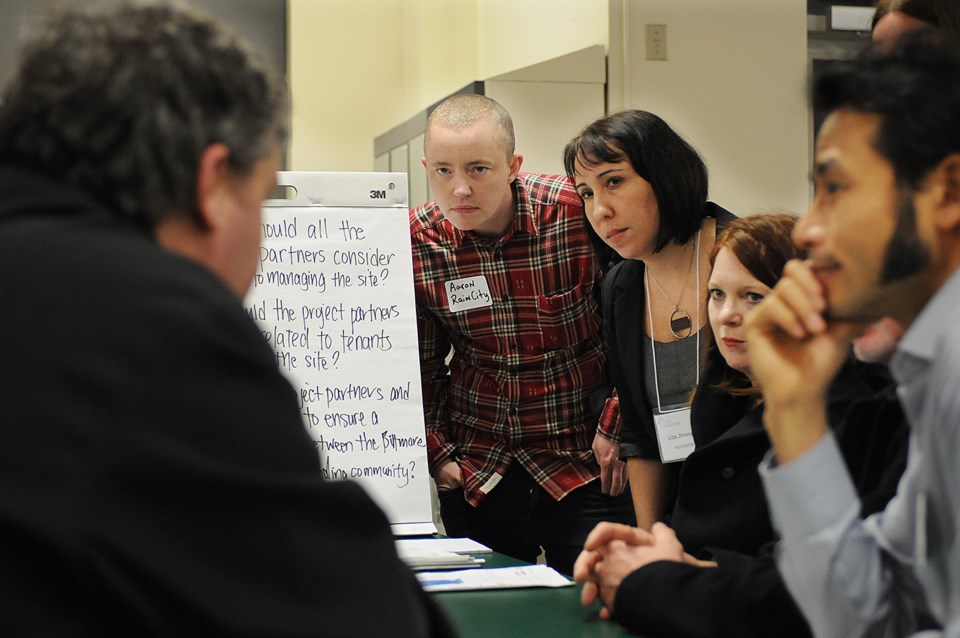Neighbourhood safety and security were among key concerns Wednesday night at a community meeting about the transformation of the former Biltmore Hotel into temporary housing for the homeless and those at risk of homelessness.
Roughly 80 people attended the event. Many were open to the new use for the building, but were worried about potential problems and how those problems will be dealt with, and they questioned why the city didn’t hold the community meeting months ago.
“I understand the city has to take care of the homeless, my issue is with security,” Brad Campbell told the Courier, adding “security is a hard thing to address.” Campbell lives across the street and said he’s going to suggest his strata install cameras.
The hotel is expected to re-open in early February. B.C. Housing has a six-year lease for 95 rooms, with an option to renew the lease for up to nine additional years. The ground-floor commercial space is not part of the lease. The units will provide temporary housing to residents while more permanent housing is being constructed.
B.C. Housing is providing $1.7 million in annual operating costs to the Biltmore and $535,000 to make the building more safe and secure. The City of Vancouver has contributed $1.1 million for renovation work.
RainCity Housing will operate the facility and the building will follow the city’s mandated housing mix of 50 per cent street or sheltered homeless, 30 per cent at risk of homelessness and 20 per cent from SROs or inadequate housing.
Residents are now being selected for the building and they will move in slowly. RainCity can evict and re-locate tenants for problems such as being violent or for significant criminal involvement that can’t be stopped. But they will be given an opportunity to learn to live indoors and RainCity will do what it can to help residents settle in their new homes.
Between 2005 and 2008, the number of people living on the street climbed from 591 to 811, according to city statistics. Since 2008, efforts to lower that figure have included building permanent housing, opening winter shelters and opening temporary housing units in buildings such as the Biltmore.
As a result, the number of street homelessness has dropped to fewer than 300, the city says. The average age of those on the street is 48, 80 per cent are male, and they are disproportionately aboriginal (30 per cent).
Raven Song Community Health Centre at Ontario and 8th will be a key contact for Biltmore residents. It’s formed an outreach team comprised of a primary care nurse, a social worker, a nurse practitioner, an addictions health care worker and a mental health clinician, which will visit Biltmore residents weekly.
Participants at the community meeting were divided into smaller groups after a short presentation and told to focus on three questions: what should project partners consider related to managing the site; what should they consider related to tenants at the site; and, what should be done to ensure a good relationship between the Biltmore and the surrounding community.
The residents asked questions including whether there would be enough support for tenants and how tenants will occupy themselves during the day. They also raised concerns about the proximity to Nightingale elementary and a seniors residence. Suggestions included needle sweeps in a greater area than just surrounding the building and that RainCity create a website that includes contact numbers, along with statistics and information to show how well the building is being managed.
Some neighbours asked how they could volunteer their services at the building, while others asked for a tour before it opens and for a housewarming party afterwards.
But concerns about security remained. Dave Romer said he’s worried about crime and disturbances in the neighbourhood.
Romer said he “fully supports” getting people off the street, housed and off their addictions, so they can become productive members of society, but he also wants to feel safe in the community.
David Lee shared similar sentiments. “I’m highly supportive of having supported housing in different neighbourhoods outside the Downtown Eastside,” he said. “I’m optimistic, but I also wanted to get information… I’m glad [the city is] doing these sessions, but I’m also curious what happens after it opens and ongoing engagement. I don’t want this to be a one-time thing.”
Lee said he’s trying not to make assumptions about people moving in, but he’ll likely be more attentive to security.
At the close of the meeting Michelle Sturino, a Residents Association Mount Pleasant (RAMP) director, slammed the city for not having the meeting “months ago.”
“Where is the transparency from city hall,” she said to some applause. “You have started this project on the wrong foot by not involving the community… it did not get started on the right foot at all.”
RAMP is hosting its own public meeting from 6:30 to 8:30 p.m. at St. Patrick's Church, Jan. 9 . The city is hosting a second community meeting at Native Education College from 10 a.m. until noon, Jan. 11.
noconnor@vancourier.com
twitter.com/naoibh



